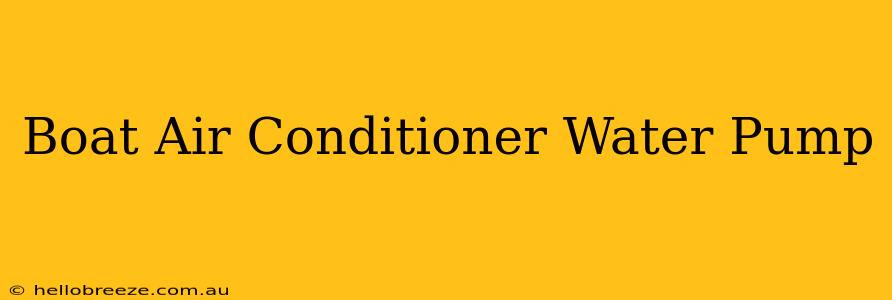Finding the right boat air conditioner water pump can be tricky, but keeping your system running smoothly is crucial for onboard comfort. This guide dives into troubleshooting, maintenance, and choosing the perfect pump for your needs.
Understanding Your Boat AC Water Pump
A boat air conditioner water pump is a vital component, responsible for circulating cooling water through the system. This water absorbs heat from the air conditioner's refrigerant, preventing overheating and ensuring efficient operation. Without a properly functioning pump, your AC will likely fail to cool effectively, or worse, overheat and sustain damage. Different boat models and AC units use different pumps, so understanding your specific system is key.
Types of Boat AC Water Pumps
Several types of pumps are used in marine air conditioning systems:
- Centrifugal Pumps: These are commonly used due to their high flow rate and relatively quiet operation. They're suitable for most boat AC systems.
- Diaphragm Pumps: These pumps offer a high pressure capability, making them useful in systems with longer or more restrictive water lines.
- Rotary Pumps: These pumps are known for their reliability but can sometimes be noisy.
Troubleshooting Common Boat AC Water Pump Issues
A malfunctioning water pump can manifest in several ways. Here are some common problems and troubleshooting steps:
Problem: No Water Flow
- Check the pump's power supply: Ensure the pump is receiving power. Check fuses, circuit breakers, and wiring connections.
- Inspect the impeller: The impeller is the rotating part of the pump that moves the water. A damaged or worn impeller needs replacement. Look for cracks, wear, or debris obstructing the impeller.
- Examine the intake strainer: A clogged strainer will restrict water flow. Clean or replace the strainer if necessary.
- Check for leaks: Leaks in the water lines can reduce flow and pressure. Carefully inspect all connections and lines.
Problem: Weak Water Flow
- Check the impeller: A partially worn or damaged impeller will reduce flow. Replace if necessary.
- Inspect the water lines: Check for kinks, obstructions, or scaling within the water lines. Clean or replace as needed.
- Verify the pump's prime: Some pumps need to be primed (filled with water) before they'll operate effectively.
Problem: Noisy Pump
- Check for cavitation: Cavitation occurs when the pump is sucking air instead of water, leading to a noisy operation and reduced performance. Check for leaks in the intake line.
- Inspect the impeller and bearings: Worn bearings or a damaged impeller can also cause excessive noise. Replace as necessary.
- Verify mounting: Make sure the pump is securely mounted to prevent vibrations.
Maintaining Your Boat AC Water Pump
Regular maintenance is key to extending the life of your boat AC water pump and preventing costly repairs. Follow these steps:
- Regularly inspect the impeller: Check the impeller for wear and tear at least once a year, or more frequently if you use your boat extensively.
- Clean the intake strainer: Clean the strainer regularly to remove debris that could restrict water flow.
- Flush the system: Periodically flush the cooling water system to remove scale and other deposits that can reduce efficiency and damage the pump.
- Lubricate moving parts (if applicable): Some pumps may require lubrication of bearings or other moving parts. Consult your pump's manual for specific instructions.
Choosing the Right Replacement Boat AC Water Pump
When replacing your water pump, consider the following factors:
- Flow rate: Select a pump with a flow rate sufficient for your air conditioner's needs.
- Pressure: Ensure the pump can provide adequate pressure to overcome any restrictions in your water lines.
- Voltage: Choose a pump with the correct voltage for your boat's electrical system.
- Compatibility: Make sure the pump is compatible with your specific boat AC unit.
By understanding your boat AC water pump, performing regular maintenance, and effectively troubleshooting problems, you can ensure a cool and comfortable boating experience for years to come. Remember, consulting your boat's manual and contacting a qualified marine technician can be invaluable for more complex issues.

